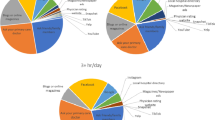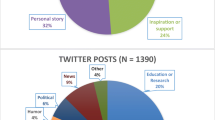Abstract
Purpose
To elicit patient preferences for social media utilization and content in the infertility clinic.
Methods
This was a cross-sectional survey study conducted in three US fertility practices. Women presenting to the infertility clinic for an initial or return visit were offered an anonymous voluntary social media survey. The survey elicited patient perception of whether social media use in the infertility clinic is beneficial, and preferences regarding topics of interest.
Results
A total of 244 surveys were collected during the study period, of which 54.5% were complete. Instagram is a more popular platform than Twitter across all age groups. Use of both platforms varies by age, with patients ≥ 40 less likely to be active users. The majority of respondents felt that social media provided benefit to the patient experience in the infertility clinic (79.9%). “Education regarding infertility testing and treatment” and “Myths and Facts about infertility” were the most popular topics for potential posts, with 93.4 and 92.0% of patients endorsing interest respectively. The least popular topic was “Newborn photos and birth announcements,” with only 47.4% endorsing interest. A little over half of respondents (56.3%) would feel comfortable with the clinic posting a picture of their infant. The vast majority of patients (96.2%) feel comfortable communicating electronically with their infertility clinic.
Conclusion
Patients are interested in the use of social media as a forum for patient education and support in the infertility clinic. Patient preferences regarding post topics should be carefully considered.

Similar content being viewed by others
References
Most famous social network sites worldwide as of August 2017, ranked by number of active users. . 2017. https://www.statista.com/statistics/272014/global-social-networks-ranked-by-number-of-users/. Accessed 30 Aug 2017.
Center PR. Social media update 2016 2016 http://www.pewinternet.org/2016/11/11/social-media-update-2016/. Accessed 30 Aug 2017.
Stewart JB. Facebook has 50 minutes of your time each day. It wants more. New York Times, 2016. https://www.nytimes.com/2016/05/06/business/facebook-bends-the-rules-of-audience-engagement-to-its-advantage.html. Accessed 28 Aug 2017.
Hammarberg K, Zosel R, Comoy C, Robertson S, Holden C, Deeks M, et al. Fertility-related knowledge and information-seeking behaviour among people of reproductive age: a qualitative study. Hum Fertil (Camb). 2017;20(2):88–95. https://doi.org/10.1080/14647273.2016.1245447.
Franasiak JM, Ku LT, Barnhart KT, Online N, Communications C. Curbside consultations in the era of social media connectivity and the creation of the Society for Reproductive Endocrinology and Infertility Forum. Fertil Steril. 2016;105(4):885–6. https://doi.org/10.1016/j.fertnstert.2016.02.007.
Google search for “infertility support” 2017. https://www.google.com/search?source=hp&q=infertility+support&oq=infertility+support&gs_l=psy-ab.3..0l4.996.3728.0.4077.20.19.0.0.0.0.123.1340.15j3.18.0....0...1.1.64.psy-ab..2.18.1337.0..0i131k1.8IRgjAi70dk. Accessed 30 Aug 2017.
Epstein YM, Rosenberg HS, Grant TV, Hemenway BAN. Use of the internet as the only outlet for talking about infertility. Fertil Steril. 2002;78(3):507–14.
Omurtag K, Jimenez PT, Ratts V, Odem R, Cooper AR. The ART of social networking: how SART member clinics are connecting with patients online. Fertil Steril. 2012;97(1):88–94. https://doi.org/10.1016/j.fertnstert.2011.10.001.
Omurtag K, Turek P. Incorporating social media into practice: a blueprint for reproductive health providers. Clin Obstet Gynecol. 2013;56(3):463–70. https://doi.org/10.1097/GRF.0b013e3182988cec.
Author information
Authors and Affiliations
Corresponding author
Ethics declarations
Conflict of interest
The authors declare that they have no conflicts of interest.
Ethical approval
All procedures performed in studies involving human participants were in accordance with the ethical standards of the institutional and/or national research committee and with the 1964 Helsinki Declaration and its later amendments or comparable ethical standards. For this type of study, formal consent is not required.
Electronic supplementary material
ESM 1
(DOCX 32 kb)
Rights and permissions
About this article
Cite this article
Broughton, D.E., Schelble, A., Cipolla, K. et al. Social media in the REI clinic: what do patients want?. J Assist Reprod Genet 35, 1259–1263 (2018). https://doi.org/10.1007/s10815-018-1189-2
Received:
Accepted:
Published:
Issue Date:
DOI: https://doi.org/10.1007/s10815-018-1189-2




